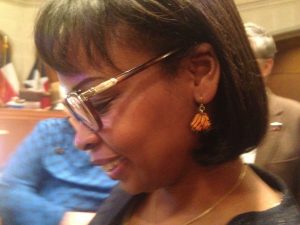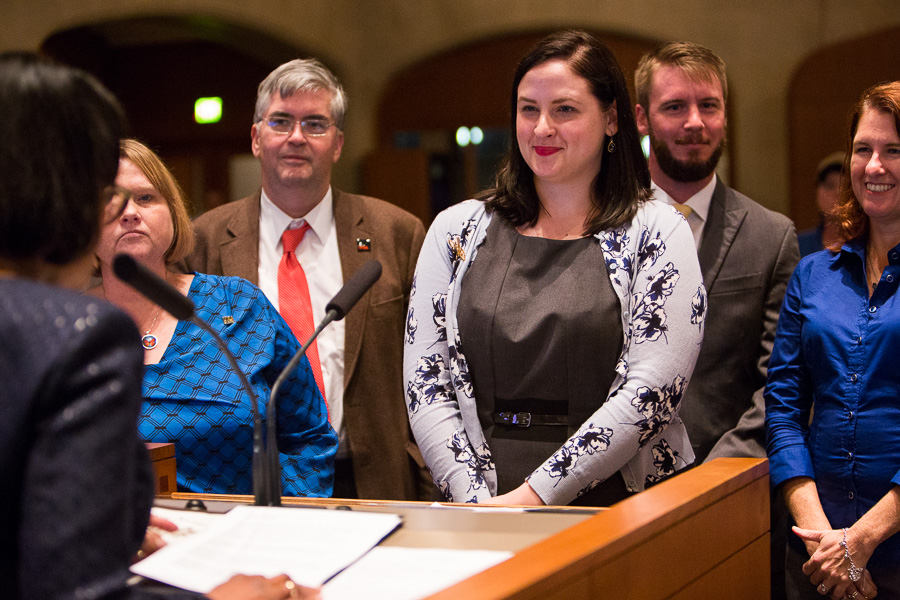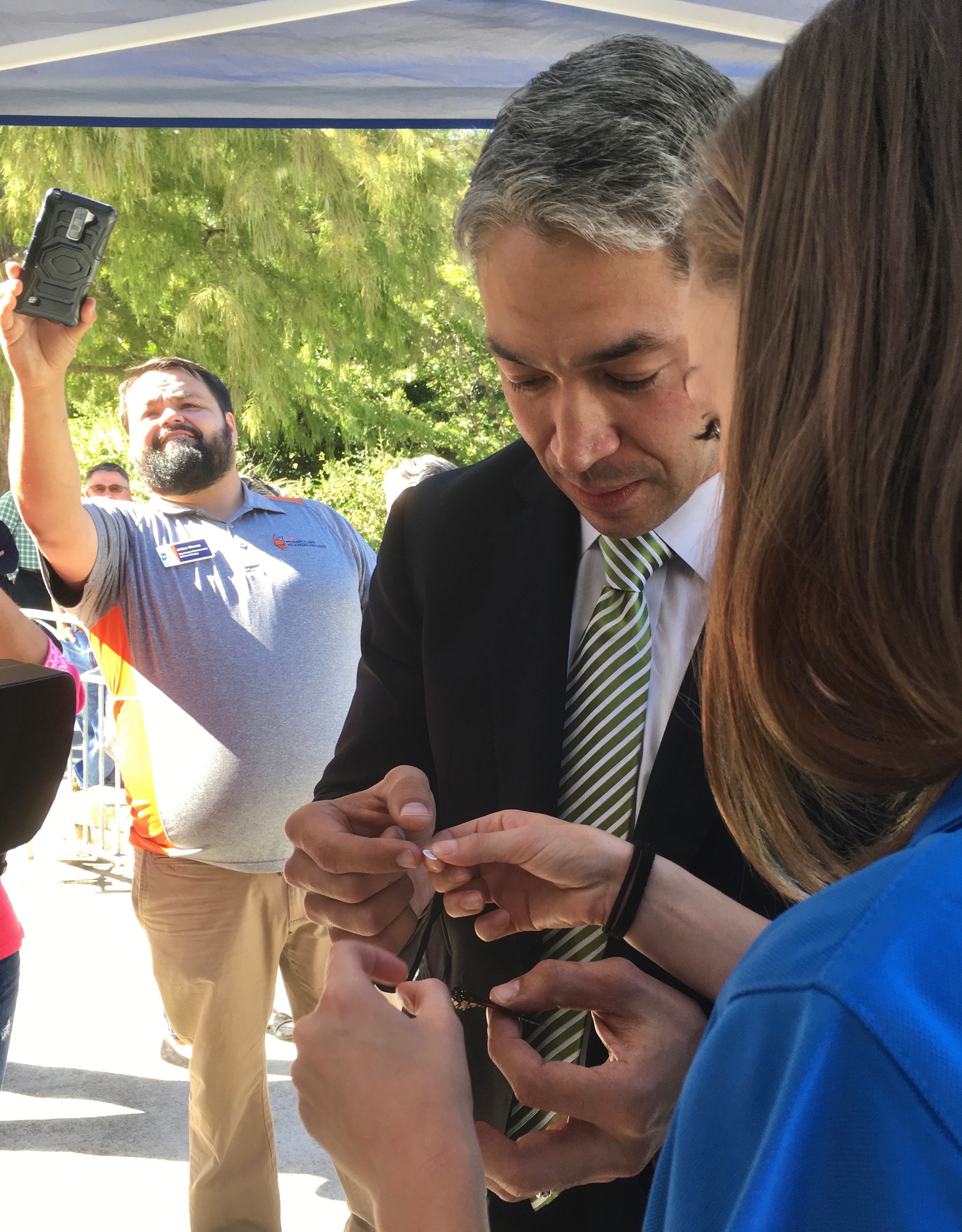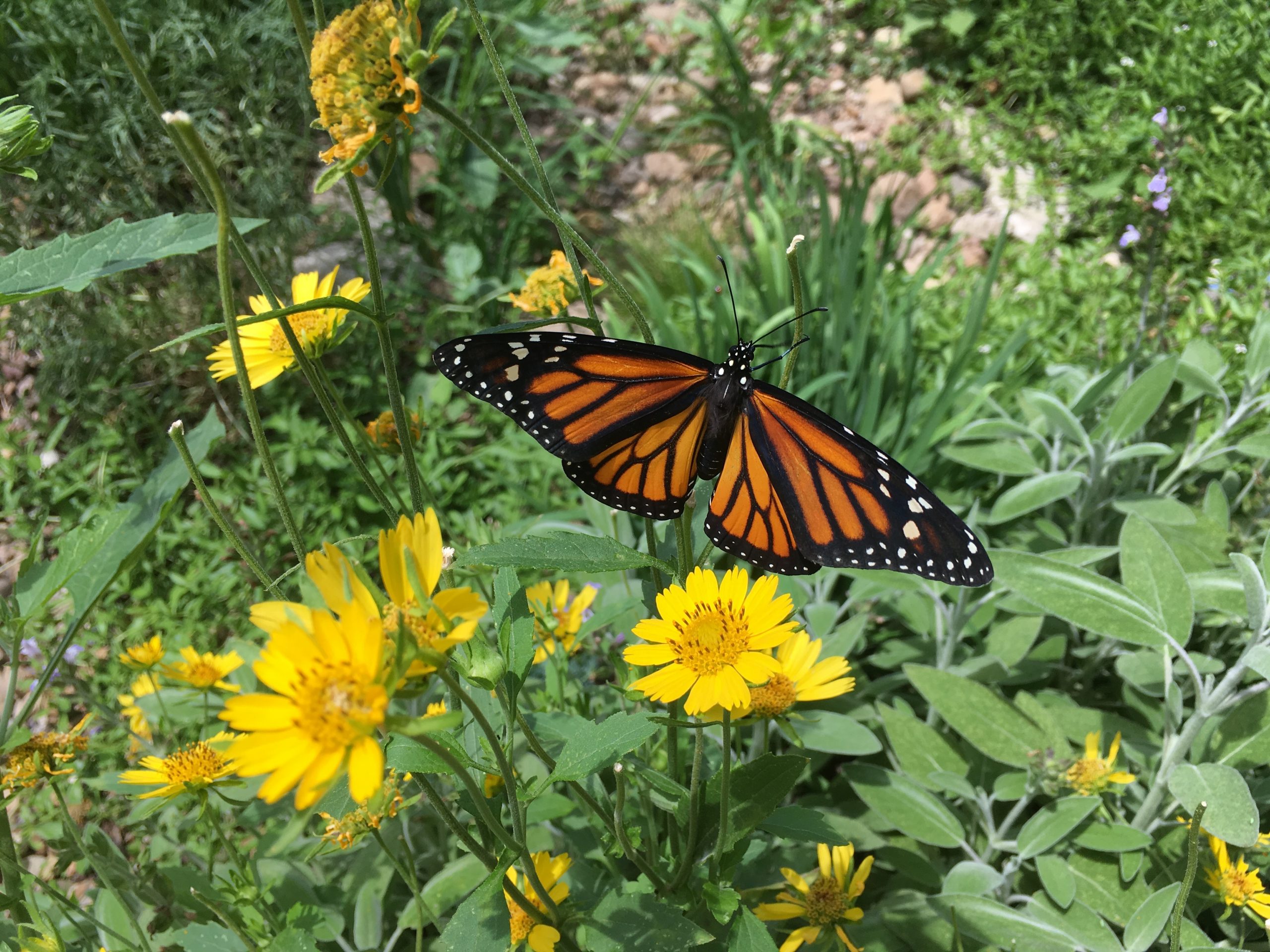San Antonio Mayor Ivy Taylor stood inside City Hall December 9, 2015, and shared the proclamation that made San Antonio the hemisphere’s first Monarch Butterfly Champion City. The act committed San Antonio to adopt all 24 recommended actions cited by the National Wildlife Federation to increase pollinator habitat in urban settings, an international initiative known as the Mayor’s Monarch Pledge.
Sporting monarch butterfly wing earrings, Taylor stood before a small group. “I am pleased that we have set the bar so high in our efforts to attract and care for one very important set of visitors, migrating monarch butterflies,” she said.
Almost five years later, Taylor departs San Antonio to become the first female president of Rust College in Holly Springs, Mississippi. We wish her the best, thank her for her service and take stock to see if San Antonio reached the high bar Taylor set.

Mayor Ivy Taylor sported her Monarch butterfly wing bling earrings. Photo by Monika Maeckle
When it was signed, Doug Melnick, Chief Sustainability Officer for the City of San Antonio, said the Mayor’s Pledge was not “just talk.”
“This will positively impact how we manage city-owned land,” said Melnick.
The Pledge called for changes in building codes, increases in pollinator habitat, new rules for landscaping by the City’s Sustainability Office, and increased grassroots activities like native plant sales, seed exchanges and butterfly festivals.
So…how are we doing?
Very well, according to local conservationists.
Taylor’s act launched “a healthy competition” among major Texas cities to jump on the pollinator conservation bandwagon, said Rebeca Quiñonez-Piñón, Monarch Outreach Coordinator for NWF.
“Her initiative built a positive momentum that helped us place Texas as the state with the largest number of Champion cities (six in total) and to host over 100 cities committed to the Pledge at different levels,” said Quiñonez-Piñón.
According to the most recent National Wildlife Federation audit of San Antonio’s progress, an incomplete tally cites more than six acres of pollinator habitat installed on city properties just last year. Several butterfly festivals, including our Monarch Butterfly and Pollinator Festival took place, and several native plant and seed exchanges occurred. A community wide pollinator gardening initiative launched here at the Texas Butterfly Ranch, now tallies 540 registered habitats.

Ivy Taylor shares the proclamation that announced San Antonio as the first Monarch Butterfly Champion status in December 2015. Photo by Scott Ball
“Awareness around the value of nature in the urban core has definitely been enhanced,” thanks to San Antonio’s Monarch Butterfly Champion status, said Julia Murphy, deputy sustainability director for the City of San Antonio.
Murphy added that under the leadership of Mayor Ron Nirenberg, who recommitted to San Antonio’s Monarch Champion status in 2017, the SA Climate Ready, Climate Action & Adaptation Plan specifically prioritizes biodiversity and healthy ecosystems as “essential mitigation and adaptation strategies for reducing greenhouse gas emissions.” And just last week, San Antonio became 1 of 10 United States Pioneer Cities by joining CitiesWithNature, an international urban sustainability initiative.

Mayor Ron Nirenberg tags a monarch butterfly on the San Antonio River after recommitting to the Mayor’s Monarch Pledge. Photo by Monika Maeckle
The San Antonio River Authority (SARA), which oversees the management of the San Antonio River, was already working on a massive riparian restoration when Taylor signed the Pledge. But her support galvanized awareness and support of SARA efforts, said Steven Schauer, vice president of public affairs for the regional governmental body.
“Mayor Taylor’s support of the Mayor’s Monarch Pledge helped shine a light on all the sustainability efforts our community was already doing,” said Schauer.
It’s worth noting that SARA’s Mission Reach riparian restoration allowed San Antonio to check off 18 of the 24 action items required to be a Monarch Champion city. Schauer says the NWF recognition coupled with UNESCO’s World Heritage recognition, also granted in 2015, raised San Antonio’s profile and set the stage for the city to win the prestigious International Riverprize in 2017.
“Taken together, the Monarch Champion City, UNESCO World Heritage designation, and the International Riverprize are proving to other cities around the world that larger-scale ecosystem restoration as well as small-scale, localized rain (and pollinator) gardens can be accomplished and provide multiple positive benefits in an urban environment,” said Schauer.
Over at SAWS, the city’s award-winning water utility, conservation director Karen Guz said San Antonio’s Monarch Champion status helped the utility sell the idea of native plant landscaping as a responsible approach to water conservation.
“Who doesn’t like monarch butterflies?” posed Guz, citing the monarch butterfly’s enduring charisma. “People don’t have the same reaction to bees.”
Monarch Championship recently helped paved the way for a wildscaping project at SAWS’ H2Oaks facility, a water purification plant.
“We’d been seeing lots of wildflowers when we drove out there, but it was all mowed around SAWs,” said Guz, describing the Southside wildflower sprays that surround the desalination plant.
Last fall, SAWS utilized no till seed drills to plant 2,200 pounds of native wildflower seed on 10 acres at the plant . Seed drilling tends to result in higher wildflower germination than simply seed broadcasting.
Laurie Brown, program director of the the Cibolo Nature Center and Farm, also noted impacts from San Antonio’s Monarch Championship.
“Many organizations from other cities in the United States, Canada, and Mexico have looked at San Antonio as a monarch conservation model in an urban environment,” said Brown, who organized the City’s first Monarch Festival in a previous position at the San Antonio Zoo in 2016.
Brown serves as chief organizer of San Antonio’s volunteer Alamo Area Monarch Collaborative (AAMC), a direct offshoot of the Mayor’s Monarch Pledge. She sees the AAMC as the “single most important act” that resulted from the initiative, because it united many conservation organizations to “tackle habitat goals, educational gaps, community training and events, to produce more citizen scientists and continue the work in our communities.”
Brown noted that the conservation work continues today, adding “I hope Mayor Taylor will bring that love for a certain orange winged insect with her to Rust College in Mississippi.”
TOP PHOTO: Monarch butterfly nectars on Cowpen Daisy in a downtown San Antonio pollinator garden.
Related posts:
- Happy 50th Earth Day: monarch butterflies enjoy a win, of sorts
- Mayor’s Monarch Pledge not “just talk,” will change how San Antonio manages land
- Endangered Species Act: wrong tool for monarch butterfly conservation?
- USFWS gets three more years to evaluate monarch butterfly ESA status
- Founder of the monarch butterfly roosting sites lives a quiet life in Austin, Texas
- Entry to Mexico’s most popular monarch butterfly preserve should cost more than $2.77
- How to plan a successful butterfly garden
- What will happen to pollinator advocacy under President Donald Trump?
Like what you’re reading? Don’t miss a single post from the Texas Butterfly Ranch. Sign up for email delivery, or follow us on Facebook, Twitter, or Instagram.


Where is SA finding their milkweed? I live in Corpus Christi and all I can find is the commercial tropical milkweed. Do you have a source or sources you can provide me that carries the native milkweeds? It is very difficult to find. Also, I need sources for native plants too, if you could give me some native plant nursery names and locations. I travel around Texas a lot, so I am not opposed to driving to get plants.
Any help would be appreciated.
Elizabeth James
We bought a variety seeds package online. The instructions require it to be frozen the seeds for a while before planting.We have some seedlings coming up.
Maas Nursery in league City Texas has a wonderful mix. You can also plant lantana, indigo spires, red sage Italian parsley,
Fill, Fennel.
The caterpillars LOVE FENNEL. it is a host plant. The milk weed goes so fast. They are hungry little critters
Monarchs only eat milkweed.
Swallowtail caterpillars eat fennel.
They can look similar.
Seedsource.com, AKA Native American Seed, specializes in Native Texas species. They have a great selection of mixes for Butterflies, Pollinators, Birds, Bees, Humming Birds as well as single species and Wildflower Mixes. They also carry native turf mixes, prairie mixes and restoration mixes. I an naturalizing my yards with small areas of Native Sun Turf mix and will follow up with mostly a Pollinator Garden. The turf mix is coming on very strong.